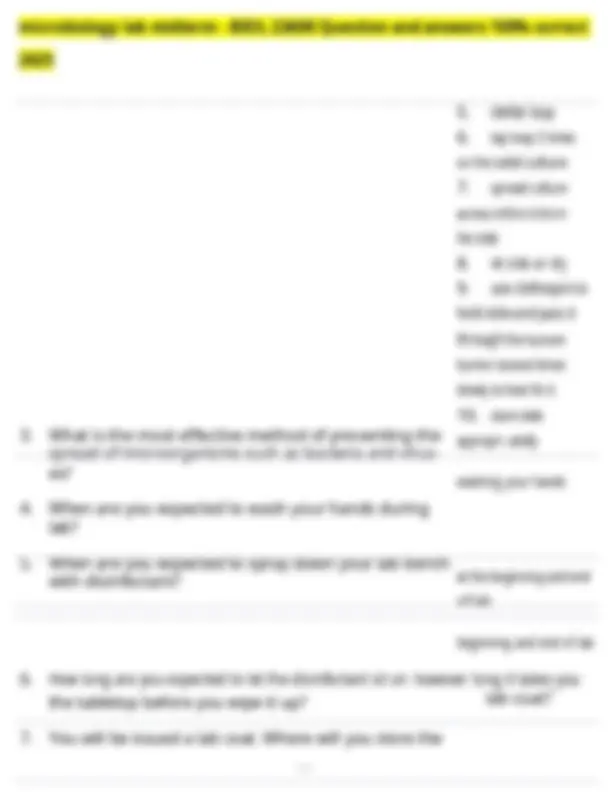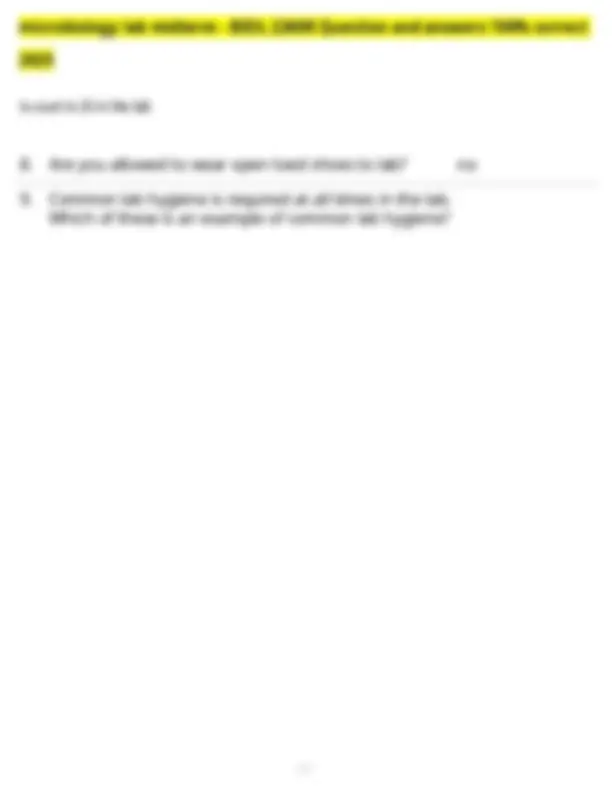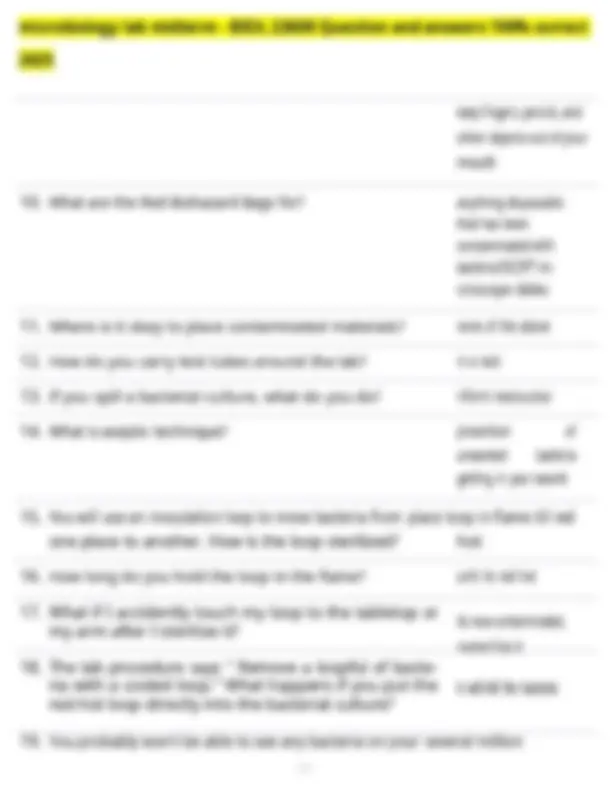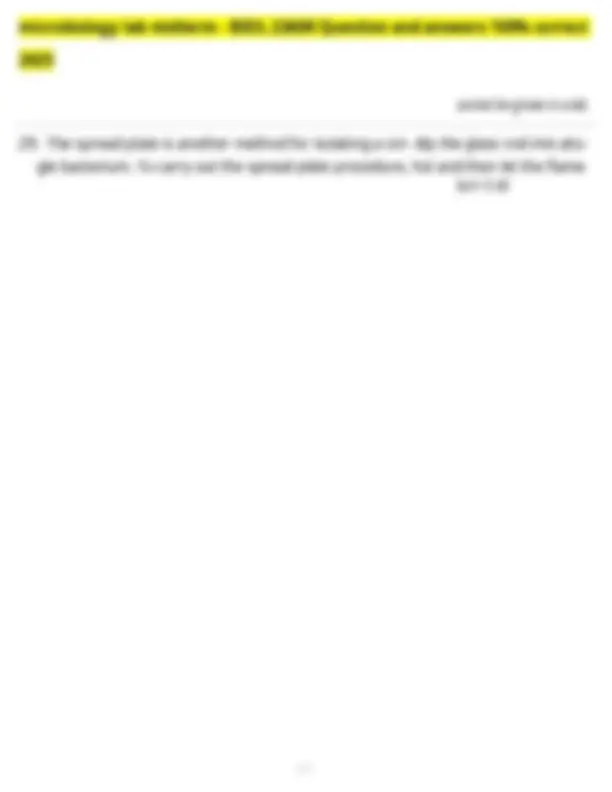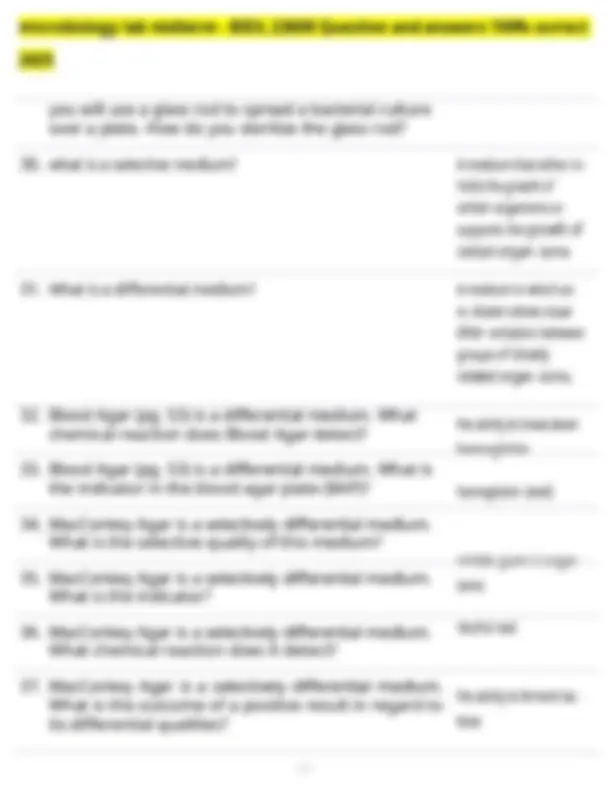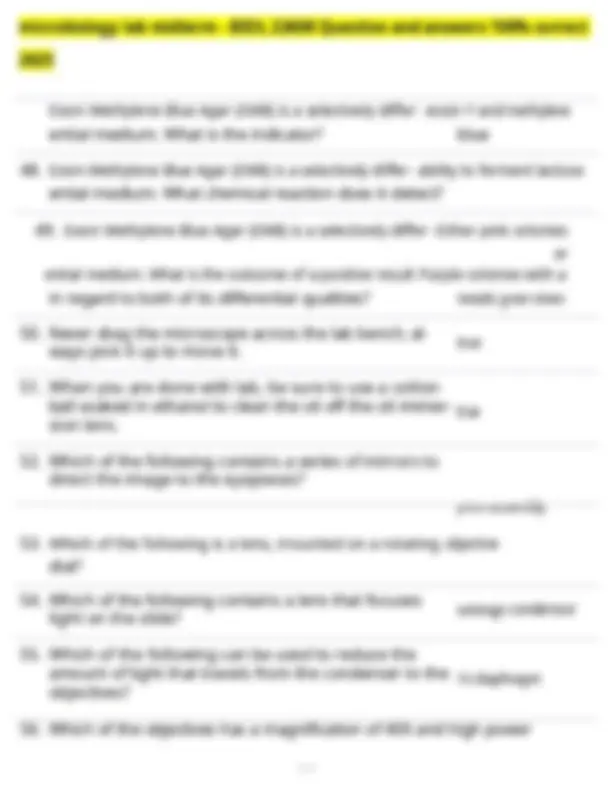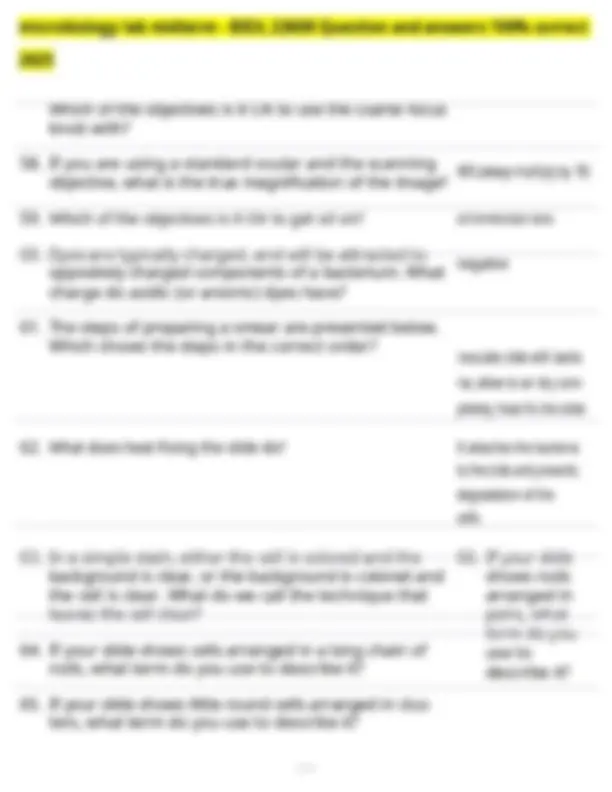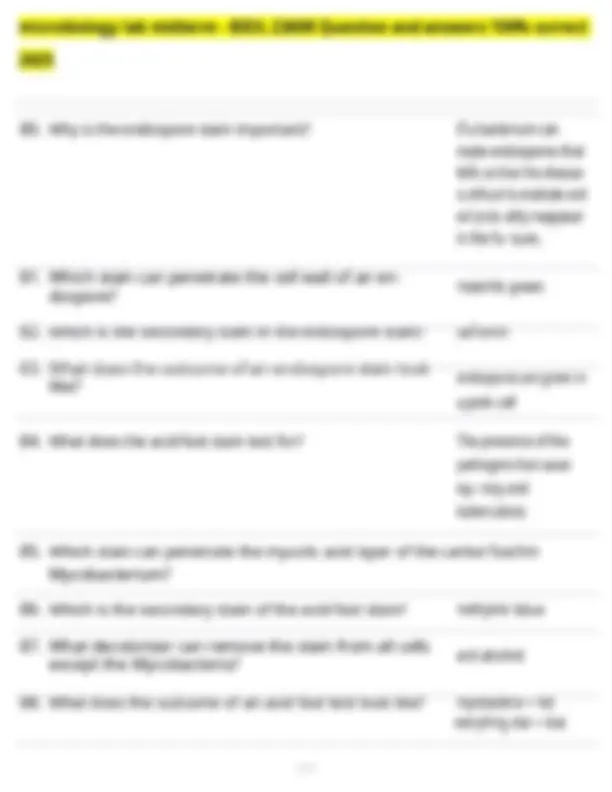Download microbiology lab midterm - BIOL 2260K Question and answers 100% correct 2025 and more Exams Microbiology in PDF only on Docsity!
- Draw a streak plate, list the steps: (WRITTEN) 1. sterilize the loop
- inoculate bacteria
- streak across top 1/4 of plate
- sterilize loop
- drag from edge of 1st streak across second 1/4 of plate
- sterilize
- drag from streak 2
- sterilize
- drag from 3rd streak to the center
- sterilize
- List the steps preparing a smear from a solid and heat 1. obtain a clean slide, flip fixing it (WRITTEN) over, and draw a circle the size of a quarter with a marking pen 2. label the slide on the cloudy part 3. flip slide
- sterilize loop, get a loop full of distilled water and drop onto the slide, spread inside circle with loop.
to count to 20 in the lab
- Are you allowed to wear open toed shoes to lab? no
- Common lab hygiene is required at all times in the lab. Which of these is an example of common lab hygiene?
keep fingers, pencils, and other objects out of your mouth
- What are the Red Biohazard Bags for? anything disposable that has been contaminated with bacteria EXCEPT mi- croscope slides
- Where is it okay to place contaminated materials? none of the above
- How do you carry test tubes around the lab? in a rack
- If you spill a bacterial culture, what do you do? inform instructor
- What is aseptic technique? prevention of unwanted bacteria getting in your work
- You will use an inoculation loop to move bacteria from place loop in flame till red one place to another. How is the loop sterilized? hot
- How long do you hold the loop in the flame? until its red hot
- What if I accidently touch my loop to the tabletop or my arm after I sterilize it?
- The lab procedure says " Remove a loopful of bacte- ria with a cooled loop." What happens if you put the red-hot loop directly into the bacterial culture? its now contaminated, resterilize it it will kill the bacteria
- You probably won't be able to see any bacteria on your several million
- Where do you put the cap of the test tube after you open the tube?
- How does what you do with the cap of the tube trans- late to what you do with lid of the petri dish (plate)? Where do you put the lid while you are working in the plate?
- When a bacterial culture is stored, the bacteria often sink to the bottom of the tube. How are bacteria dis- persed back into the liquid culture?
- How do you spread bacteria across a solid medium (the agar plate) with the loop? never set the cap down never set the lid down gently swirl the bottom of tube in a circle skate the loop across the medium
- What is the goal of performing a streak plate? To separate the bacteria into individual organisms
- If a single bacterium is isolated on the growth medium, colony it will divide and grow into a visible mass of genetically identical organisms. What is this visible mass called?
- Which is a characteristic of Complex Media? The exact chemical con- stituents are unknown.
- Which is a characteristic of a Defined Medium? The exact chemical con- stituents are known.
- Most of the bacteria in the environment... are not well known and
cannot be grown in a lab
- The spread plate is another method for isolating a sin- dip the glass rod into alco- gle bacterium. To carry out the spread plate procedure, hol and then let the flame burn it ott
pink colonies
- Mannitol Salt Agar is a selectively differential medium. Only Staphlylococci can What is the selective quality of this medium? grow^ in^ these^ high salt concentrations
- Mannitol Salt Agar is a selectively differential medium. phenol red What is the indicator?
- Mannitol Salt Agar is a selectively differential medium. the ability to ferment man- What chemical reaction does it detect?
- Mannitol SaltAgar is a selectively differential medium. nitol yellow media around the What is the outcome of a positive result in regard to its colonies differential qualities?
- Salmonella-Shigella Agar is a selectively differential medium. What is the selective quality of this medium?
- Salmonella-Shigella Agar is a selectively differential medium. What is the indicator?
- Salmonella-Shigella Agar is a selectively differential medium. What chemical reaction does it detect?
- Salmonella-Shigella Agar is a selectively differential medium. What is the outcome of a positive result in regard to both of its differential qualities?
- Eosin Methylene Blue Agar (EMB) is a selectively dif- ferential medium. What is the selective quality of this medium? inhibits gram (+) bacteria neutral red and iron sul- fide Both the ability to ferment lactose and the ability to break down iron sulfide (FeS). Either or Both pink colonies and colonies that are black in the center.
Eosin Methylene Blue Agar (EMB) is a selectively differ- eosin Y and methylene ential medium. What is the indicator? blue
- Eosin Methylene Blue Agar (EMB) is a selectively differ- ability to ferment lactose ential medium. What chemical reaction does it detect?
- Eosin Methylene Blue Agar (EMB) is a selectively differ- Either pink colonies or ential medium. What is the outcome of a positive result Purple colonies with a in regard to both of its differential qualities?
- Never drag the microscope across the lab bench; al- ways pick it up to move it.
- When you are done with lab, be sure to use a cotton ball soaked in ethanol to clean the oil off the oil immer- sion lens.
- Which of the following contains a series of mirrors to direct the image to the eyepieces? metallic green sheen true true prism assembly
- Which of the following is a lens, mounted on a rotating objective dial?
- Which of the following contains a lens that focuses light on the slide?
- Which of the following can be used to reduce the amount of light that travels from the condenser to the objectives? substage condensor iris diaphragm
- Which of the objectives has a magnification of 40X and high power
can only be used with the fine focus?
- scanning
negative stain streptobacillus staphlyococcus diplobacillus
- If your slide shows little round cells arranged in cubes sarcina of eight, what term do you use to describe it?
- In the procedure for smear and simple stain, you will be using a pad of Bibulous paper. How and for what do you use this paper? gently; to dry the slide
- In the procedure for smear prep and simple stain, how 3 minutes long should you let the dye sit on the slide?
- What is the primary stain? crystal violet
- What is the secondary stain? safranin
- What is the mordant? grams iodine
- What do the cells look like after being stained with the all cells are purple primary stain?
- What do the cells look like after being decolorized? gram (+) = purple gram (-) = colorless
- What does the mordant do? fixes the primary stain in gram (+) cells
- What is the decolorizer? ethanol
- In the procedure, which step is the most "fiddly," step - applying the decolorizer the step where you are most likely to make a mistake?
- What do the cells look like after applying the secondary gram (+) = purple stain?
- Why do we need to know what cell wall a bacterium has?
- Why is the endospore stain important? If a bacterium can make endospores that tells us that the disease is diflcult to eradicate and will prob- ably reappear in the fu- ture.
- Which stain can penetrate the cell wall of an en- dospore? malachite green
- Which is the secondary stain in the endospore stain? safranin
- What does the outcome of an endospore stain look like? endospores are green in a pink cell
- What does the acid-fast stain test for? The presence of the pathogens that cause lep- rosy and tuberculosis
- Which stain can penetrate the mycolic acid layer of the carbol fuschin Mycobacterium?
- Which is the secondary stain of the acid-fast stain? methylene blue
- What decolorizer can remove the stain from all cells except the Mycobacteria? acid alcohol
- What does the outcome of an acid fast test look like? mycobacteria = red everything else = blue

